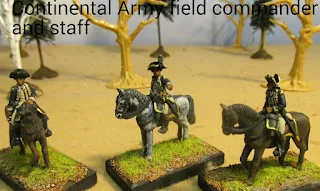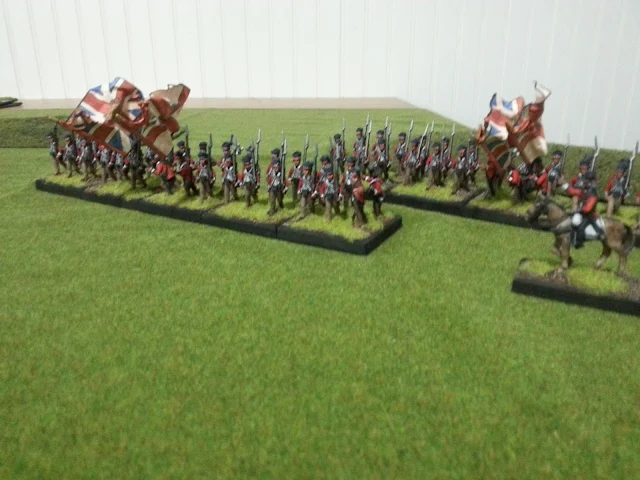I have been playing "Charge of the Light Brigade" since 2003. These are home brewed self published rules from the author David Raybin so possibly only a few of you have tried them. I thought I would share some of my impressions about the rules and how they play. I will also post a battle report of a game we played with pictures to show how they work in a latter post. They provide a fun game which captures the spirit of the period and deserve a wider audience.
I will state right off I am a big fan of these rules. I like simple rules, but with a twist. I like regiments to look like regiments. And it is important to me that that a group of colorful miniature soldiers represents such and such a regiment. I want a game I can play in a evening, gives a period "feel" for the time period played, have fun with and come to a conclusion. "Charge of the Light Brigade" does all of these.
The rules are a simple I Go U Go but with a difference. Each side rolls for initiative with high side getting first go. If you won the roll last time you add one to your roll. Each of your regiments or batteries do one action (move, change formation, fire or remove a morale point). To move roll two dice (or more depending on formation) and that is how far you can move. After all your units have moved you may spend a command point (CP) per unit and that unit may do a second thing.
Here is something that sets this set of rules aside from all others. The author has taken the simple move/counter move system and twisted it. Every unit has a commander (i.e. Colonel). He has so many command points (CP). More if he and the regiment are good, less if mediocare or poor. Russians often get around 8 (sluggish, dull) while British line get 12 and elite Guards might get as many of 16. Better units can do more at critical times. But when your CP are gone they are gone.
OK, now it is your turn, and every unit on your side has done one free action. You may then spend a CP and do something else. Fire, remove a Morale marker or what ever. It gives you a chance to take advantage of something or react to what is happeneing on the table. BUT for every action there is a reaction and the enemy now gets to react against that unit and can either return fire at you or change position/facing. But only against the enemy that spent that CP. In a past game a Russian battalion removed a Morale pip by paying a CP. The British reacted by firing at the unit and puting 2 morale pips right on back (darn good shooting with the Guards who rolled four 6's). So you spends your money and takes your chaces. This portion of the rules is what gets a lot of comments and attention from people who have played this game for the first time. And rightly so. It is simple, inovative and fun. But I would recommend a GM to run the first few games you try to ensure you all stay on tract and not move ahead. To track CP I put a sticky note under the command figure stand with the number of that units CP.

Firing is simple. You throw 1D6 per stand for Infantry and 2D6 per artillery stand. Cross refinance with the firing chart for weapon vs. target and this gives you the chances for a hit. Since there is a possible saving roll you might not lose all those figures hit. Yes, the dreaded saving roll. But here it takes the place of all those calculations you have to do with other rules. Watch out for double 6's as they can cause a morale marker to drop onto your unit. Each infantry stand has four figures. Once all four figures are gone you remove the stand. Until then the stand fights on.
To me, the neat thing about this system is that you forget about calculation, tables and charts. Hits, saves and morale are all tied into each other. The save chart also brings a little of the old "national modifiers" into the mix. With Russians, who get saved on a 5 or 6 no matter how many stands are left you have to beat each one with a stick until they are all dead. You get that steady, dogged feeling you read about. The British start with a high save chance (they dodge bullets like the bat man said the rules auther) but as they loose stands save chances go way down so they wither away. A little fragile. Poor Johnny Turk never gets a save
Morale is a sneaky system that most folks don't think a lot about until it bites them! You get a morale pip for any number of things (crossing an obstacle, being fired at or having friends route past you). Since you subtract 1 pip from every die roll morale effects everything you do. Move, shot or fight it ties into morale.
In a past game a Russia commander with three morale markers on a regiment found out fast that he could not shoot, or save casualties with that unit. With morale markers, once you get into trouble it comes fast and furious. To me this is a superior system then used in many rules. The unit is effected, and everything it can do is effected.
Close Combats takes a bit getting used to since it is very different from most rules. You do not charge like in other rules. You move within 2' of the enemy. THEN, you would have to pay a Command Point or wait till next turn to close and fight. This gives the defender a chance to do something. Like blast the enemy with a close range volley that causes casualties or mabey a morale marker. It is actually hard to close into close combat due to small arms fire. But when you do it can be devastating.
I really love these rules. The game feels like the Crimean to me based on my reading. Also for a I Go U Go both sides get to do something so no sitting around. In my games Russians tend to form columns (or at least reinforced lines) and try and close with the British quickly. (One player has nicked named them "Zulu's in overcoats.") Russian artillery is better then the allies and there is a lot of it. Russian cavalry is, well, sluggish. The British tend to want to shoot at things. And shoot a lot. Cavalry is small but very aggressive. By the way small numbers of cavalry will not damage infantry who can usually shoot them down before they close. Many of my games have seen a single British battalion stopping massed charge like at Balaklva. The French are interesting as their line have muskets while elite troops like Zouaves have rifles and more CP. So each army is very different from the other. You have to work with what you have and get the best out of them.



































